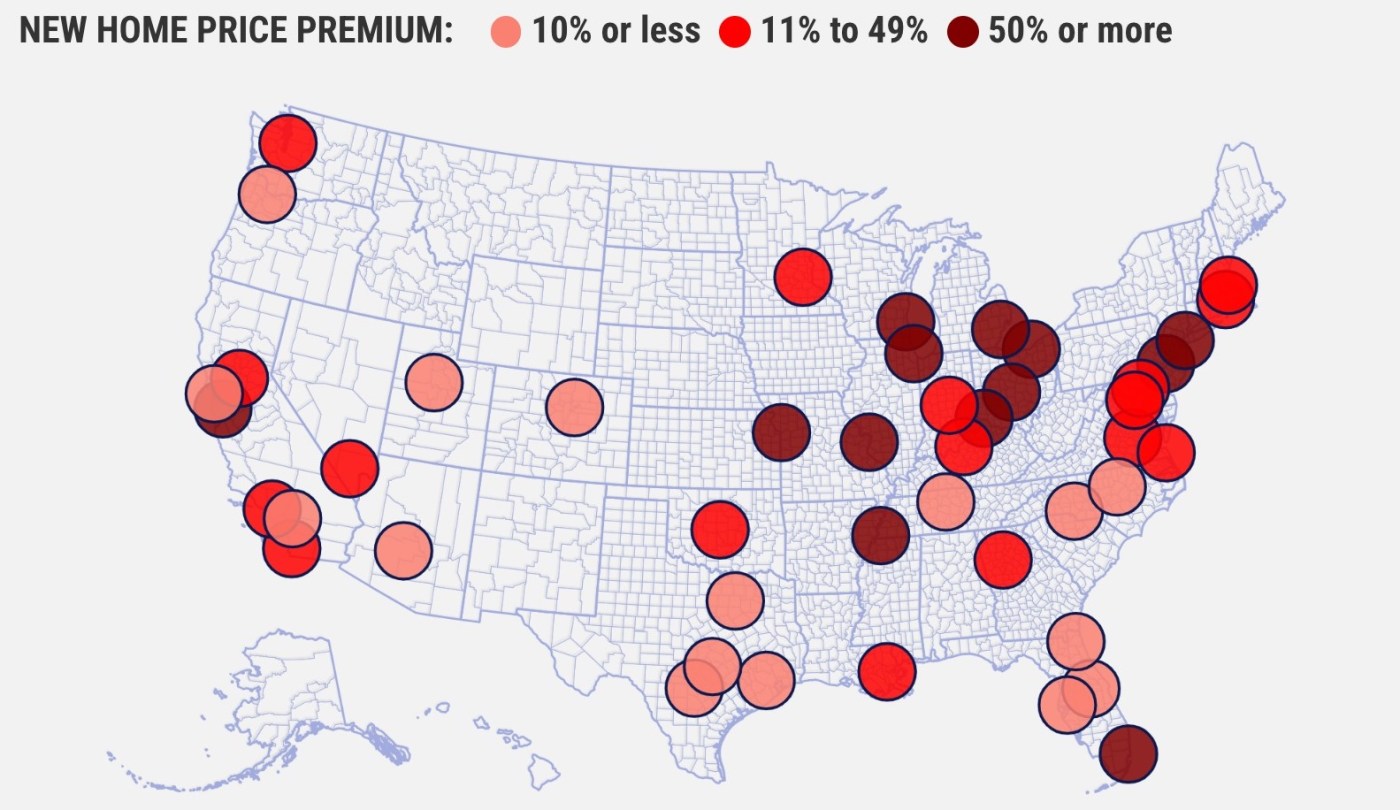“Numerology” tries to find reality within various measurements of economic and real estate trends.
Buzz: Construction is not a quick cure for homebuying affordability headaches because the bulk of the new homes being built are pricier and larger than the rest of what’s sold on the market.
Source: My trusty spreadsheet spied a Zillow study comparing existing residences sold in May with newly constructed ones in 46 big US metropolitan areas – including six in California.
Fuzzy math: Developers argue they need to build bigger homes to make the expensive land they buy, plus other construction costs, pencil out financially.
Topline
Yes, it’s only one month of sales, however, think about California through the median results for the six cities studied.
Buyers paid $1.14 million for new homes vs. $935,000 for existing ones. So what’s being built is 22% pricier.
Now some of that premium price can be tied to mortgage rate discounts offered by builders that allow house hunters to pay up for new homes.
But the bulk of those higher prices are because builders typically sold a 2,020-square-foot house vs. 1,585 for existing ones. So the new stuff is 27% larger.
Please note that this is not only a crazy California thing.
Nationally, new homes had a $418,000 median sales price vs. $365,000 existing – that’s 15% higher.
Amd US homebuyers typically got 1,990 square feet new vs. 1,710 for existing homes – 16% larger.
Details
Ponder the new vs. “used” patterns within California, ranked by the price premium builders got …
San Jose: $2.87 million median for new construction vs. $1.6 million for existing homes – 79% higher (the fourth-biggest gap of the 46 metros). That bought 2,360 square feet new vs. 1,600 existing – or 48% larger (No. 4).
Sacramento: $745,920 median new vs. $575,000 existing – 30% higher (No. 24) for 2,340 square feet new vs. 1,670 existing – 40% larger (No. 8).
San Diego: $1.14 million median new vs. $900,000 existing – 27% higher (No. 25) for 2,060 square feet new vs. 1,480 existing – 39% larger (No. 10).
Los Angeles-Orange County: $1.15 million median new vs. $970,000 existing – 19% higher (No. 27) for 1,970 square feet new vs. 1,520 existing – 30% larger (No. 16).
Inland Empire: $610,805 median new vs. $562,500 existing – 9% higher (No. 32) for 1,980 square feet new vs. 1,720 existing – 15% larger (No. 30).
San Francisco: $1.27 million median new vs. $1.23 million existing – 4% higher (No. 38) for 1,380 square feet new vs. 1,570 existing – 12% smaller (No. 46).
Bottom line
This is not just a greedy builder problem.
In large part, these pricing gaps are the result of a host of policy and marketplace challenges that make it far easier to produce high-end housing.
Related Articles
After living in 700 sf ft for 5 years, this Bay Area family wanted a bigger space. What could they find for under $1M?
From segregation to upzoning: Berkeley struggles to reform housing policies
Millbrae votes to recall councilmembers over housing issues
Sunnyvale to add 176 new affordable apartments near Lawrence Caltrain station
Eye-popping construction costs intensify California’s housing shortage
Fancy and expensive new communities are simpler to sell politically in the local regulatory process.
And that premium housing can be sold to wealthier clientele. Those sales usually produce fatter profit margins.
Catering to the upper crust can be a smoother sell to the investors and bankers who put their dollars behind construction plans. And so far in recent years, there are enough folks with deep pockets willing to gobble up the more expensive new offerings.
Peek at the 10 US metros in Zillow’s study with the smallest new-to-existing price gaps. These markets essentially had little difference in price or size of these two homebuying options.
Yet in the 10 with the largest gaps, new homes were typically 40% larger compared with new homes – and 80% pricier. (FYI: Those 10 markets, a surprising group: Columbus, St. Louis, Kansas City, Philadelphia, Detroit, Milwaukee, Cleveland – and San Jose, New York, and Miami.)
Look, there are no simple solutions to fix homebuying’s dramatic “unaffordability” problem. And relying on the easy answer – build what’s convenient – won’t work.
Yes, any new supply of housing at no matter the price point does ease inventory imbalances.
But it’s a darn slow process for noteworthy affordability improvements to trickle down from housing’s high end to help the most-stressed house hunters merely seeking a modest place of their own.
Jonathan Lansner is business columnist for the Southern California News Group. He can be reached at jlansner@scng.com












